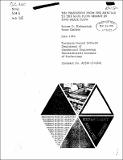The transition from the annular to the slug flow regime in two-phase flow
Author(s)
Haberstroh, Robert D.; Griffith, P.
DownloadHTL_TR_1964_028.pdf (5.370Mb)
Other Contributors
Massachusetts Institute of Technology. Division of Sponsored Research.
Massachusetts Institute of Technology. Heat Transfer Laboratory.
Metadata
Show full item recordAbstract
Experiments were conducted to determine the transition from annular to semiannular flow regimes for two-phase, gas-liquid upflow in vertical tubes. The influencesof liquid flow rate, tube diameter, liquid viscosity, surface tension, and density ratio were tested. The transition location, giving the least gas flow which will support annular flow, is correlated for low liquid flows. The effects of surface tension and liquid viscosity are small for tubes of 0.5" and greater diameter. For large liquid flows the transition occurs at constant quality. Over the range of variables tested, the void fraction at transition lies between 80% and 90%. The criterion of transition is the appearance of liquid plugs which intermittently bridge across the tube. The pressure drop and volume void fraction at transition are reported but not correlated. Recommendations for extension of the experimental results to untested conditions are presented.
Date issued
1964Publisher
Cambridge, Mass. : M.I.T. Division of Sponsored Research, [1964]
Other identifiers
15187808
Series/Report no.
Technical report (Massachusetts Institute of Technology, Heat Transfer Laboratory) ; no. 28.
Keywords
Gas flow., Pipe -- Fluid dynamics.